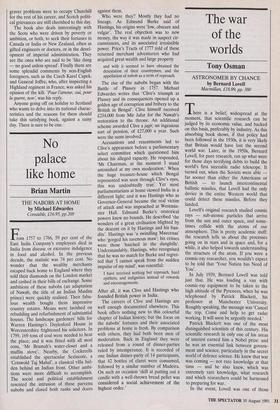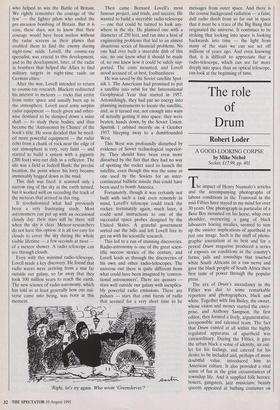The war of the worlds
Tony Osman
ASTRONOMER BY CHANCE by Bernard Lovell Macmillan, £18.99, pp. 380 There is a belief, widespread at the moment, that scientific research can be judged by its economic value, and backed on this basis, preferably by industry. As this absorbing book shows, if that policy had been followed in the 1930s, it is very likely that Britain would have lost the second world war. Later, in the 1950s, Bernard Lovell, for pure research, ran up what were for those days terrifying debts to build the world's first steerable radio telescope. It turned out, when the Soviets were able — far sooner than either the Americans or British — to launch intercontinental ballistic missiles, that Lovell had the only device in the entire Western world that could detect these missiles. Before they landed.
Lovell's original research studied cosmic rays — sub-atomic particles that arrive from the sun and outer space, and some- times collide with the atoms of our atmosphere. This is pretty academic stuff: the research tells us about the processes going on in stars and in space and, for a while, it also helped towards understanding the structure of the atom. If you were a cosmic-ray researcher, you wouldn't expect to be told that 'Your Nation has Need of You'.
In July 1939, Bernard Lovell was told just that. He was loading a van with cosmic-ray equipment to be taken to the high altitude of the Pyrenees, when he was telephoned by Patrick Blackett, his professor at Manchester University. Roughly speaking, the message was -`Cancel the trip. Come and help to get radar working. It will soon be urgently needed.'
Patrick Blackett was one of the most distinguished scientists of this century. His scientific research in only one of his areas of interest earned him a Nobel prize: and he was an essential link between govern- ment and science, particularly in the secret world of defence science. He knew that war was coming — not rare knowledge at that time — and he also knew, which was extremely rare knowledge, what research and which researchers could be harnessed to preparing for war.
In the event, Lovell was one of those
who helped to win the Battle of Britain. We rightly remember the courage of 'the few' — the fighter pilots who ended the pre-invasion bombing of Britain. But it is easy, these days, not to know that their courage would have been useless without the radar screens in their planes that enabled them to find the enemy during night-time raids. Lovell, the cosmic-ray specialist, was crucial to this development, and to the development, later, of the radar in bombers that helped the Allies to find military targets in night-time raids on German cities.
After the war, Lovell intended to return to cosmic-ray research. Blackett redirected his interest to meteors — rocks that arrive from outer space and usually burn up in the atmosphere. Lovell used army surplus radar equipment — freely given and other- wise destined to be dumped down a mine shaft — to study these bodies, and thus became the 'Astronomer by Chance' of the book's title. He soon decided that he need- ed more powerful equipment — the radar echo from a chunk of rock near the edge of our atmosphere is very, very faint — and started to build a system with a gigantic (200 foot) wire-net dish as a reflector. The site was a field at Jodrell Bank; the precise location, the point where his lorry became immovably bogged down in the mud.
This dish was fixed: it scanned only a narrow ring of the sky as the earth turned, but it worked well on recording the track of the meteors that arrived in this ring.
It revolutionised what had previously been a very frustrating study. Most astronomers can put up with an occasional cloudy day: their stars will be there still when the sky is clear. Meteor-researchers do not have this option: it is all too easy for clouds to cover the sky during the whole visible lifetime — a few seconds at most of a meteor shower. A radio telescope can see through clouds.
Even with this minimal radio-telescope, Lovell made a key discovery. He found that radio waves were arriving from a star far outside our galaxy, so far away that they took 100 million years to reach the earth. The new science of radio-astronomy, which has told us at least generally how our uni- verse came into being, was born at this moment. Then came Bernard Lovell's most famous project, and trials, and success. He wanted to build a steerable radio-telescope — one that could be turned to look any- where in the sky. He planned one with a diameter of 250 feet, and ran into a host of engineering problems that led to an almost disastrous series of financial problems. No one had ever built a steerable dish of this size, no one knew what it should be made of, no one knew how it could be safely sup- ported. The costs mounted, and Lovell stood accused of, at best, foolhardiness.
He was saved by the Soviet satellite Sput- nik 1. The Americans had promised to put a satellite into orbit for the International Geophysical Year that started in 1957. Astonishingly, they had put no energy into planning instruments to locate the satellite, and, as it turned out, not enough into ways of actually getting it into space: they were beaten, hands down, by the Soviet Union. Sputnik 1 orbited merrily on 4 October 1957, bleeping away to a dumbfounded West.
This West was profoundly disturbed by evidence of Soviet technological superior- ity. They should have been even more disturbed by the fact that they had no way of spotting the rocket used to launch the satellite, even though this was the same as one used by the Soviets for an inter- continental ballistic missile that could have been used to bomb America.
Fortunately, though it was certainly not built with such a task even remotely in mind, Lovell's telescope could track the rocket: fortunately again, much later, it could send instructions to one of the successful space probes designed by the United States. A grateful government sorted out the bills and left Lovell free to get on with his scientific research.
This led to a run of stunning discoveries. Radio-astronomy is one of the great scien- tific success stories of the century, and Lovell leads us through the discoveries of his own and other radio-telescopes. The universe out there is quite different from what could have been imagined by 'conven- tional astronomers'. There are quasars stars well outside our galaxy with inexplica- bly powerful radio emissions. There are pulsars — stars that emit bursts of radio that seemed for a very short time to be
`Right, let's try again. Who wrote `Greensleeves'?
messages from outer space. And there is the cosmic background radiation — a faint, dull radio throb from so far out in space that it must be a trace of the Big Bang that originated the universe. It continues to be striking that looking into space is looking backwards into time — the light from many of the stars we can see set off millions of years ago. And even knowing that, it is difficult to appreciate that a radio-telescope, which can see far more deeply into space than an optical telescope, can look at the beginning of time.



















































 Previous page
Previous page